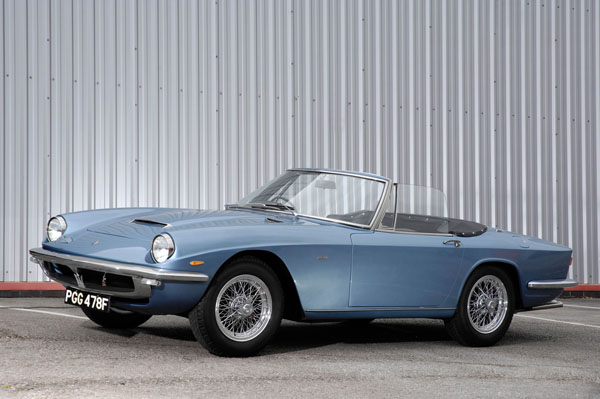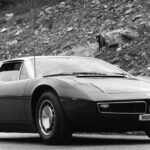Maserati’s Mistral was a stunning car to look at and although not introduced until 1963 it had its conception in the 1950s when Maserati’s reputation was at its height after the success of its outstandingly attractive grand prix car, the 250F. At that time Jaguar were selling ever-increasing numbers of production cars as a result of the exploits of their equally beautiful sports racers, so Maserati could see no reason why they should not benefit in the same way but at a higher price level.
To start with chief engineer Giulio Alfieri reworked the distinctly Jaguar-like twin overhead camshaft straight six-cylinder 3.5-litre engine of the 350S sports racer to make it suitable for larger-scale production in a grand touring car so that it could produce profits as vast as its appearance was exotic. It had to look even better than a Jaguar under the bonnet to justify a far higher price. To achieve this it was equipped with two spark plugs per cylinder giving it as many as a V12 Ferrari and also those accessories worn by every high performance car: three twin-choke Weber carburettors.
The chassis was made from steel tubing of varying section with no sign of the scientific weight-saving practiced by the likes of Lotus. It had a gearbox and steering gear supplied by ZF in Germany, the final drive by Salisbury in Britain and the Girling brakes and clutch were the same as used by Jaguar.
This predecessor to the Mistral started as the 3500GT with Touring making the fixed-head coupes and Vignale the convertible Spiders and sales soared from 119 to a peak of more than 500 in 1961 as Maseratis sports racing cars swept everything before them in the United States.
Eventually the 3500GT had disc brakes on all four wheels, Lucas fuel injection, as used on later examples of the D type Jaguar, and a more modern five-speed gearbox from ZF. Vignale also produced a more futuristic-looking fixed-head coupe with four headlamps called the Sebring. It certainly looked exotic, but the fact remained it was not as fast as an E type Jaguar which cost less than a third of the price. Maseratis were also going out of fashion on the race track.
To counter declining sales the Mistral was introduced. This still used 3500GT/Sebring mechanical components, but with a neat fixed head, or convertible, style by Frua. Initally the car had the 3.5-litre engine but later there was a 3692 cc/183 kW six, and eventually a 4012 cc/190 kW option which was the final stretch of the long-serving twin-cam unit, descended from the early 1950s single-seater racing cars. Using this engine the Mistral was capable of a 250 km/h maximum speed.
The Mistral became far more popular with a wealthy clientele which wanted a car more exclusive than a Jaguar or a Porsche, and one with a body as exotic as any Ferrari. But the number of people who could afford such extravagances, and who remembered the glories of Maserati’s past, was declining, so the Mistral failed to dominate the American market. More than 800 Mistral fixed-head coupes and 120 Spiders were produced in the six years to 1970, which was double the number of Sebrings.










